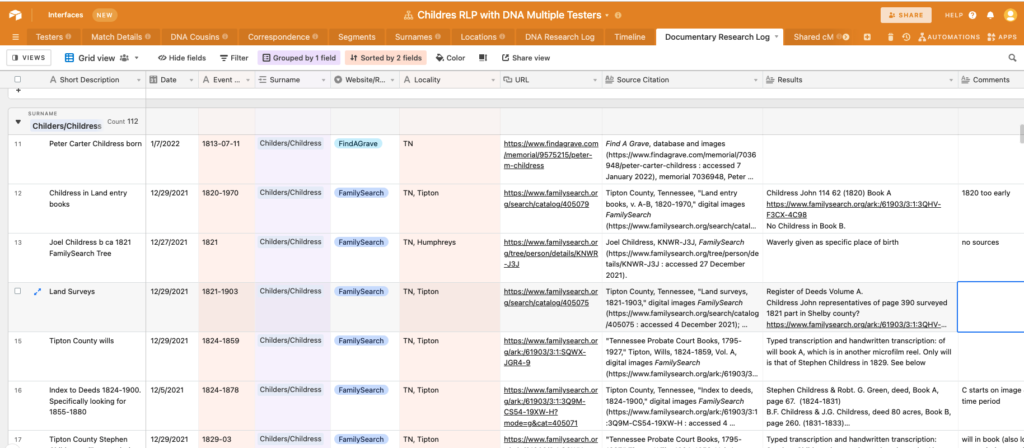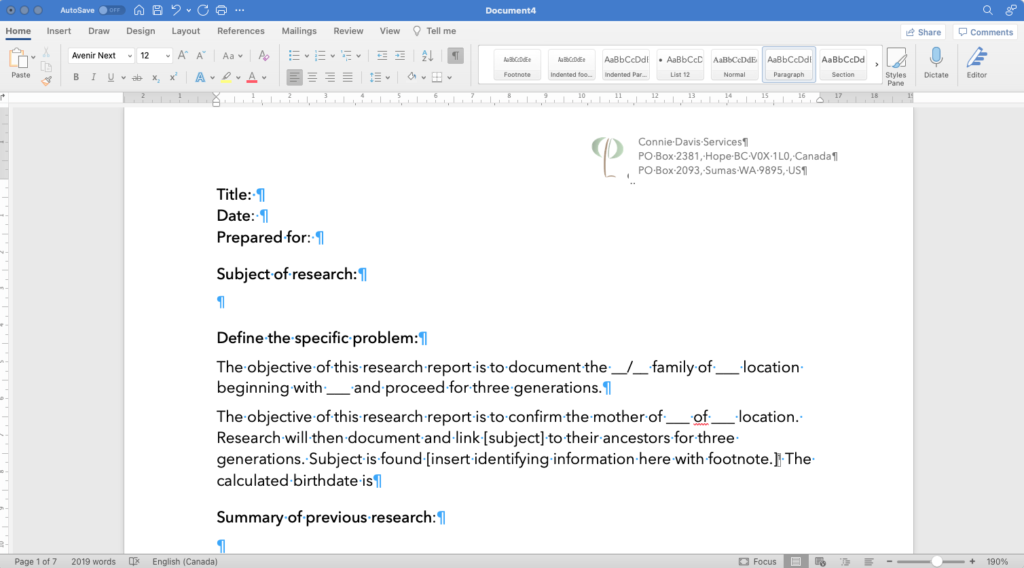Every new project has a honeymoon period. There’s the anticipation of what might be discovered and the pleasure of setting up the project so that the research proceeds smoothly. Here’s a glimpse into my project set-up process.
Research Log
A little over a year ago I started using Airtable as my research log. I have enough understanding of programming to be dangerous. I even took a class in Fortran in college and I learned how to use Microsoft Access when I worked in a health services research setting. I love relational databases even more than I love spreadsheets. Airtable is a “spreadsheet-database hybrid with features of a database but applied to a spreadsheet” according to Wikipedia. Nicole Dyer of Research Like a Pro (RLP) with FamilyLocket has shared terrific bases (templates) in the Airtable Universe. I developed my own adaptations to Nicole’s RLP with DNA Multiple Testers Base.
Below is a screenshot of the documentary research log I use based on Nicole’s template. I’ve grouped this log by surname (4th column), then sorted it by date of event (3rd column) then locality (5th column). Dates are written in YYYY-MM-DD format to sort the records (rows) by a field (column). Place names begin with the two-digit state abbreviation, followed by county, and town. This arrangement also supports sorting without creating multiple fields to sort. And if you are looking at column 8, yes, I do create the citations when I first look at the document. I have a citation template (also in Airtable).

Digital Filing
Every project has a folder on my drive which is backed up to Dropbox. The folder organization varies by project. The snapshot below is for my mysterious 2x-great grandmother, Mattie Childress. Each research question has a numbered file. “00-Mattie death date” and “01-Parents for Mattie” are examples. Nested within the folder are sub-folders for phases of research. “Archive” holds prior drafts and will be discarded at the end of a project. “Analysis” contains tables for census or timeline analysis. “Images” has screenshots of diagrams.

I’ve used Google Docs and Sheets and struggle to use the filing system in Google Drive. Many people use them to good results. Using Google docs, sheets and drive allows sharing through links. I get around this by sharing Dropbox folders for large files.
Naming conventions
File names for individual items (documents, images, spreadsheets) have evolved. There are two styles I use consistently: Name of document first or date first. When I am writing a report, the name of the document is written with underscores, then the date, always in YYYY-MM-DD format.
Childres_father_2022-01-31.docx
For sources (scans of originals, downloaded census, birth, marriage, death, etc.) I lead with the date, followed by the last name in caps, then location and type of record. I use dashes between elements of the date in YYYY-MM-DD format. This creates an instant timeline in my folders. Locations are organized from large geographic region to small.
1879-05-08_CHILDRESS_Bill_TN_Tipton_indictment_riot.jpeg
Report template
I set up the project report using a template and “write as I go.” Writing the report while I’m working supports the analysis process and I’m not faced with a blank page at the end. When working on client projects, writing-as-I-go also helps me stay within hourly limits for a project. The template, like naming conventions, has evolved over time. I use a Microsoft Word .dotx file which includes sample paragraphs I often need (such as explaining the usages of different types of DNA tests or how autosomal DNA is used to predict relationships).

I started a new project two weeks ago and set it up as described here. I can spend a few minutes or several hours researching knowing that I can focus on the research and analysis. And I’m enjoying the honeymoon!
